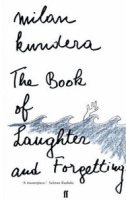What I talk about when I talk about ‘user outcomes’ #4
 I re-read Milan Kundera’s The Book of Laughter and Forgetting last week. It’s not a straightforward read but it’s certainly a challenging and rewarding one. Kundera describes it as “a novel in the form of variations” and “like the various stages of a voyage leading into the interior of a theme”.
I re-read Milan Kundera’s The Book of Laughter and Forgetting last week. It’s not a straightforward read but it’s certainly a challenging and rewarding one. Kundera describes it as “a novel in the form of variations” and “like the various stages of a voyage leading into the interior of a theme”.
To my mind, that theme is the importance not only of History, but celebrating it in its multiple forms and from a variety of perspectives. In terms of user outcomes, therefore, I think that there’s a delicate line to be drawn between influence and obliteration:
The future is an indifferent void no one cares about, but the past is filled with life, and it’s countenance is irritating, repellant, wounding, to the point that we want to destroy or repaint it. We want to be masters of the future only for the power to change the past. We fight for access to the labs where we can retouch photos and rewrite biographies and history. (p.30-31)
“You begin to liquidate a people,” Hübl said, “by taking away it’s memory. You destroy it’s books, it’s culture, it’s history. And then others write other books for it, give another culture to it, invent another history for it. Then the people slowly begins to forget what it is and what it was. The world at large forgets it still faster.” (p.218)
History is a series of ephemeral changes, while eternal values are immutable, perpetuated outside history, and have no need of memory. (p.257)
During the last two hundred years the blackbird has abandoned the woods to become a city bird. First in Great Britain at the end of the eighteenth century, then several decades later in Paris and the Ruhr Valley. Throughout the nineteenth century it conquered the cities of Europe one after another. It settled in Vienna and Prague around 1900, then spread eatward to Budapest, Belgrade, Istanbul.
From the planet’s point of view, the blackbird’s invasion of the human world is certainly more important than the Spanish invasion of South America or the return to Palestine of the Jews. A shift in the relationship among the various kinds of creation (fish, birds, humans, plants) is a shift of a higher order than changes in relations among various groups of the same kind. Whether Celts or Slavs inhabit Bohemia, whether Romanians or Russians conquer Bessarabia, is more or less the same to the earth. But when the blackbird betrayed nature to follow humans into their artificial, unnatural world, something changed in the organic structure of the planet.” (p.267-8)
This idea of one of the most important changes from our planet’s point of view taking place without us noticing really made me sit up and think. But it was this last quotation which was the clincher for me writing this post:
The best possible progressive ideas are those that include a strong enough dose of provocation to make it’s supporters feel proud of being original, but at the same time attract so many adherents that the risk of being an isolated exception is immediately averted by the noisy approval of a triumphant crowd.” (p.273)
In other words, if you want to change things for the better and achieve improved user outcomes, you need to build a constituency. You need to make an idea powerful enough that people are attracted into its orbit.
